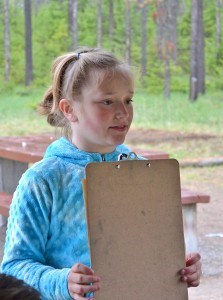
For the last eight weeks, Grade 3 students from Jasper Elementary School have been jetting across the park, taking part in field school activities which aim to teach them all about animal life cycles.
The idea, according to teacher Annemarie Macdonald, is to help the students explore the park, and teach them as much as possible about the creatures that inhabit it.
“One of Katherine and I’s biggest goals is to have these kids know everything there is to know about Jasper National Park by the time they leave Grade 3,” she said from Lake Annette, June 4, referring to her and her colleague Katherine Howe.
Around her, students crowded into cook houses, creating traditional legends based on the animals they’ve learned about. In about half an hour the students were set to present their legends to their peers, and many were practicing their stories out loud.
In one corner, Isabella Heinamann, Dylan Dekker and Janelle Tank practiced, taking turns reading from the illustrated page they spent the last hour creating. Their legend, “how the white-tailed deer got its tail”, involved a mooing rabbit, a combative fox and a polar bear who gets a little too bitey.
As they talked out their story, Macdonald approached them.
“What’s a different way of saying ‘the next day’?” Macdonald asked them. She was met with open, inquisitive mouths.
“What about the rising of the next sun?” she said, and the students’ eyes lit up in excitement as they turned to one another and chattered.
Howe explained that she and Macdonald have spent a lot of time talking to their students about the difference between a field trip and field school.
“These guys are fully in tune with the fact that they are here to learn,” she said, adding that over the course of the field school, they’ve also talked a lot about how they learn—whether they prefer video conferences, getting their hands dirty outside, or even reading from books.
And with the packed schedule of the past eight weeks, those options have been plentiful.
The classes had the students travel down Highway 16 on a wildlife tour; visit Parks Canada’s resource conservation freezer for a look at specimens of the park’s many native animals; tag along with Parks’ John Wilmshurst for an elk survey; and take part in more than 20 other activities. They even had a videoconference with an underwater diver, live, as he explored the Great Barrier Reef.
For their part, the students said they have enjoyed the outings, and each one bragged about something different that they learned.
Michael Hayashi liked the elk survey, while Colton Thomas said he enjoyed “learning about the red squirrels because I like their fluffy tails.”
Apollo Hardman was enthralled by the visit to the Parks freezer.
“It was really cool. I never got to see that many animals before,” he said.
“We’ve had lots of professionals from Parks—and interpreters—come with us. Lots and lots and lots of experts,” Howe said, noting this experiential learning only works with support from the community.
“We need the support and expertise of our community partners and parent group to make our vision a reality for our students, and we have been so fortunate to have that amazing support,” Macdonald explained.
Trevor Nichols
[email protected]
